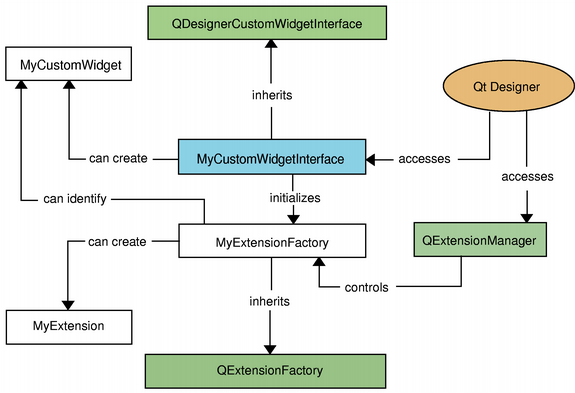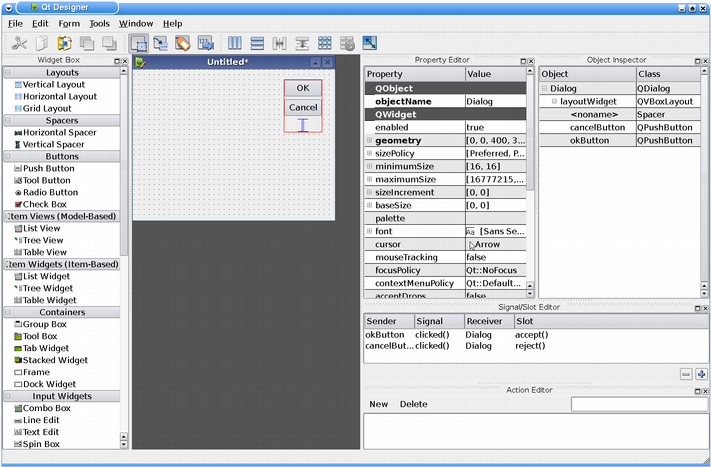QtDesigner Module
|
| QAbstractExtensionFactory | Interface for extension factories in Qt Designer |
|---|---|
| QAbstractExtensionManager | Interface for extension managers in Qt Designer |
| QAbstractFormBuilder | Default implementation for classes that create user interfaces at run-time |
| QDesignerActionEditorInterface | Allows you to change the focus of Qt Designer's action editor |
| QDesignerContainerExtension | Allows you to add pages to a custom multi-page container in Qt Designer's workspace |
| QDesignerCustomWidgetCollectionInterface | Allows you to include several custom widgets in one single library |
| QDesignerCustomWidgetInterface | Enables Qt Designer to access and construct custom widgets |
| QDesignerDynamicPropertySheetExtension | Allows you to manipulate a widget's dynamic properties in Qt Designer's property editor |
| QDesignerFormEditorInterface | Allows you to access Qt Designer's various components |
| QDesignerFormWindowCursorInterface | Allows you to query and modify a form window's widget selection, and in addition modify the properties of all the form's widgets |
| QDesignerFormWindowInterface | Allows you to query and manipulate form windows appearing in Qt Designer's workspace |
| QDesignerFormWindowManagerInterface | Allows you to manipulate the collection of form windows in Qt Designer, and control Qt Designer's form editing actions |
| QDesignerMemberSheetExtension | Allows you to manipulate a widget's member functions which is displayed when configuring connections using Qt Designer's mode for editing signals and slots |
| QDesignerObjectInspectorInterface | Allows you to change the focus of Qt Designer's object inspector |
| QDesignerPropertyEditorInterface | Allows you to query and manipulate the current state of Qt Designer's property editor |
| QDesignerPropertySheetExtension | Allows you to manipulate a widget's properties which is displayed in Qt Designer's property editor |
| QDesignerTaskMenuExtension | Allows you to add custom menu entries to Qt Designer's task menu |
| QDesignerWidgetBoxInterface | Allows you to control the contents of Qt Designer's widget box |
| QExtensionFactory | Allows you to create a factory that is able to make instances of custom extensions in Qt Designer |
| QExtensionManager | Extension management facilities for Qt Designer |
| QFormBuilder | Used to dynamically construct user interfaces from .ui files at run-time |
Detailed Description
In addition, the QFormBuilder class provides the possibility of constructing user interfaces from .ui files at run-time.
To include the definitions of the module's classes, use the following directive:
#include <QtDesigner>
To link against the module, add this line to your qmake .pro file:
CONFIG += designer
Note: These classes are part of the Qt Open Source Edition and Qt Full Framework Edition for commercial users.
- Creating Custom Widget Plugins
- Retrieving Access to Qt Designer Components
- Creating User Interfaces at Run-Time
Creating Custom Widget Plugins
When implementing a custom widget plugin for Qt Designer, you must subclass QDesignerCustomWidgetInterface to expose your custom widget to Qt Designer. A single custom widget plugin is built as a separate library. If you want to include several custom widget plugins in the same library, you must in addition subclass QDesignerCustomWidgetCollectionInterface.
To provide your custom widget plugin with the expected behavior and functionality within Qt Designer's workspace you can subclass the associated extension classes:
The QDesignerContainerExtension class allows you to add pages to a custom multi-page container. The QDesignerTaskMenuExtension class allows you to add custom menu entries to Qt Designer's task menu. The QDesignerMemberSheetExtension class allows you to manipulate a widget's member functions which is displayed when configuring connections using Qt Designer's mode for editing signals and slots. And finally, the QDesignerPropertySheetExtension class allows you to manipulate a widget's properties which is displayed in Qt Designer's property editor.

In Qt Designer the extensions are not created until they are required. For that reason, when implementing extensions, you must also subclass QExtensionFactory, i.e create a class that is able to make instances of your extensions. In addition, you must make Qt Designer's extension manager register your factory; the extension manager controls the construction of extensions as they are required, and you can access it through QDesignerFormEditorInterface and QExtensionManager.
For a complete example creating a custom widget plugin with an extension, see the Task Menu Extension or Container Extension examples.
Retrieving Access to Qt Designer Components
The purpose of the classes mentioned in this section is to provide access to Qt Designer's components, managers and workspace, and they are not intended to be instantiated directly.
Qt Designer is composed by several components. It has an action editor, a property editor, widget box and object inspector which you can view in its workspace.

Qt Designer also has an object that works behind the scene; it contains the logic that integrates all of Qt Designer's components into a coherent application. You can access this object, using the QDesignerFormEditorInterface, to retrieve interfaces to Qt Designer's components:
- QDesignerActionEditorInterface
- QDesignerObjectInspectorInterface
- QDesignerPropertyEditorInterface
- QDesignerWidgetBoxInterface
In addition, you can use QDesignerFormEditorInterface to retrieve interfaces to Qt Designer's extension manager (QExtensionManager) and form window manager (QDesignerFormWindowManagerInterface). The extension manager controls the construction of extensions as they are required, while the form window manager controls the form windows appearing in Qt Designer's workspace.
Once you have an interface to Qt Designer's form window manager (QDesignerFormWindowManagerInterface), you also have access to all the form windows currently appearing in Qt Designer's workspace: The QDesignerFormWindowInterface class allows you to query and manipulate the form windows, and it provides an interface to the form windows' cursors. QDesignerFormWindowCursorInterface is a convenience class allowing you to query and modify a given form window's widget selection, and in addition modify the properties of all the form's widgets.
Creating User Interfaces at Run-Time
The QtDesigner module contains the QFormBuilder class that provides a mechanism for dynamically creating user interfaces at run-time, based on .ui files created with Qt Designer. This class is typically used by custom components and applications that embed Qt Designer. Standalone applications that need to dynamically generate user interfaces at run-time use the QUiLoader class, found in the QtUiTools module.
For a complete example using QUiLoader, see the Calculator Builder example.
See also Qt Designer Manual and QtUiTools Module.
[Previous: Qt3Support Module] [Qt's Modules] [Next: QtUiTools Module]
Best Of
Actualités les plus lues
- « Quelque chose ne va vraiment pas avec les développeurs "modernes" », un développeur à "l'ancienne" critique la multiplication des bibliothèques 64
- 2017 : un quinquennat pour une nouvelle version du C++ ? Possible, selon Herb Sutter 5
- Créer des applications avec un style Metro avec Qt, exemples en QML et C++, un article du blog Digia traduit par Thibaut Cuvelier 0
- Orientation de l'écran en QML, un article de Christophe Dumez traduit par Thibaut Cuvelier 0
- « Quelque chose ne va vraiment pas avec les développeurs "modernes" », un développeur à "l'ancienne" critique la multiplication des bibliothèques 64
- Apercevoir la troisième dimension ou l'utilisation multithreadée d'OpenGL dans Qt, un article des Qt Quarterly traduit par Guillaume Belz 0
- Les développeurs ignorent-ils trop les failles découvertes dans leur code ? Prenez-vous en compte les remarques des autres ? 17
- BlackBerry 10 : premières images du prochain OS de RIM qui devrait intégrer des widgets et des tuiles inspirées de Windows Phone 0
- Quelles nouveautés de C++11 Visual C++ doit-il rapidement intégrer ? Donnez-nous votre avis 10
- Adieu qmake, bienvenue qbs : Qt Building Suite, un outil déclaratif et extensible pour la compilation de projets Qt 17
- La rubrique Qt a besoin de vous ! 1

- Linus Torvalds : le "C++ est un langage horrible", en justifiant le choix du C pour le système de gestion de version Git 100
- Comment prendre en compte l'utilisateur dans vos applications ? Pour un développeur, « 90 % des utilisateurs sont des idiots » 229
- Quel est LE livre que tout développeur doit lire absolument ? Celui qui vous a le plus marqué et inspiré 96
- Apple cède et s'engage à payer des droits à Nokia, le conflit des brevets entre les deux firmes s'achève 158
- Nokia porte à nouveau plainte contre Apple pour violation de sept nouveaux brevets 158
- Quel est le code dont vous êtes le plus fier ? Pourquoi l'avez-vous écrit ? Et pourquoi vous a-t-il donné autant de satisfaction ? 83
- Le Draft final de la norme C++ 0X validé 181

Le blog Digia au hasard

Déploiement d'applications Qt Commercial sur les tablettes Windows 8
Communauté
Ressources
- 91 cours et tutoriels Qt
- F.A.Q. Qt : 200 questions et réponses
- 48 Qt Quarterly, 35 Qt Labs et 22 Qt DevNet en français
- 43 outils Qt
- 99 sources Qt
- 26 binaires Qt
- 6 livres Qt et 9 critiques
- La documentation de Qt 4.7 en français : 157 classes, 70 concepts et 24 modules
- 3 certifications Qt
Liens utiles
Contact
- Vous souhaitez rejoindre la rédaction ou proposer un tutoriel, une traduction, une question... ? Postez dans le forum Contribuez ou contactez-nous par MP ou par email (voir en bas de page).
Qt dans le magazine
| Cette page est une traduction d'une page de la documentation de Qt, écrite par Nokia Corporation and/or its subsidiary(-ies). Les éventuels problèmes résultant d'une mauvaise traduction ne sont pas imputables à Nokia. | Qt qtextended4.4 | |
| Copyright © 2012 Developpez LLC. Tous droits réservés Developpez LLC. Aucune reproduction, même partielle, ne peut être faite de ce site et de l'ensemble de son contenu : textes, documents et images sans l'autorisation expresse de Developpez LLC. Sinon, vous encourez selon la loi jusqu'à 3 ans de prison et jusqu'à 300 000 E de dommages et intérêts. Cette page est déposée à la SACD. | ||
| Vous avez déniché une erreur ? Un bug ? Une redirection cassée ? Ou tout autre problème, quel qu'il soit ? Ou bien vous désirez participer à ce projet de traduction ? N'hésitez pas à nous contacter ou par MP ! | ||
Copyright © 2000-2012 - www.developpez.com



















